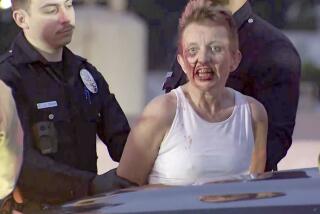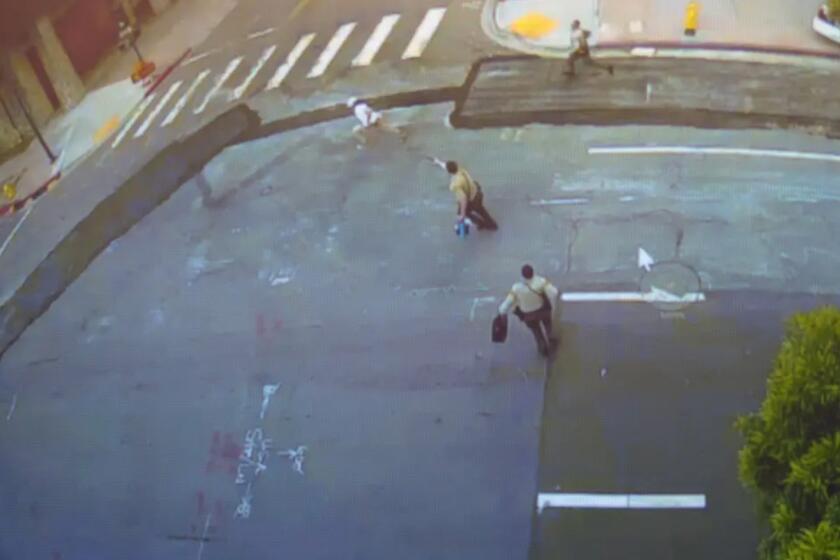Battered Wife Will Get Parole in Murder
Gov. Gray Davis agreed Wednesday to grant parole to a woman who said she killed her husband because he abused her--only the second time in 84 cases that Davis has moved to let a convicted murderer go free from prison.
The decision means Cheryl Sellers, 43, will be released from the California Institution for Women in Corona in September 2003, the date set by the state Board of Prison Terms. Advocates, who had mobilized across the state on Sellers’ behalf, said they hoped Davis’ decision would pave the way to free other inmates who killed their batterers.
Sellers was granted parole in December by the parole board, which concluded that battered woman syndrome drove her to kill Norman Sellers 19 years ago. Under the law, her case went to Davis, who had the power to block her release--as he has done in 83 of 84 murder cases he has reviewed as governor.
In this case, Davis said that although Sellers “committed a grave crime,” she killed her husband “in reaction to the abuse and threats.”
Moreover, he said, the law did not allow testimony on battered woman syndrome at the time of Sellers’ trial, meaning the jury heard no such evidence.
“The [parole board] determined Ms. Sellers would pose a low degree of risk to public safety,” Davis said in a statement. “Indeed, prior to the life crime she had no criminal history. . . . She now accepts responsibility for what she did and expresses remorse.”
In considering Sellers’ parole, Davis faced a delicate political quandary, caught between those who advocate a tough-on-crime stance and women’s groups that pressed for parole.
Many groups lobbied for Sellers’ release, among them the Legislature’s women’s caucus and influential feminists. They argued that battered woman syndrome drove Sellers to kill, that she had been an exemplary prisoner, and that she had served enough time for the crime.
“Davis had these two large support groups opposing each other: the keep-everyone-in-prison group and the women,” said Barbara O’Connor, director of the Institute for the Study of Politics and Media at Cal State Sacramento.
Davis Denies Parole for Another Woman
Sellers’ supporters were gratified by the decision. “We’re extremely pleased,” said Carrie Hempel, an attorney for Sellers. “There was substantial evidence that she was battered by her husband. . . . It’s the right decision.”
But the prosecutor in the case, Los Angeles County Deputy Dist. Atty. Susan Catalano, disagreed. Catalano said that at the time of the crime, Sellers denied she had been beaten by her husband.
“This guy may not have been the world’s best person. I don’t know,” Catalano said in an interview Wednesday. “But he did not abuse her. And he certainly didn’t deserve to be shot.”
While he approved Sellers’ release, the governor denied parole for another battered woman inmate, Valere Boyd, 41, who shot and killed her husband, Kermit Boyd, in Riverside County in 1985.
Still, Sellers’ case had attracted the most attention, and some legislators cheered the news that she would be freed.
Sen. Martha Escutia (D-Whittier), chairwoman of the Legislature’s women’s caucus, stood outside the governor’s office awaiting word on Sellers’ fate Wednesday evening. When she heard the news, she declared herself thrilled.
Senate President Pro Tem John Burton (D-San Francisco), who for years has urged the early release of battered women inmates, said he hoped Davis’ action is “a harbinger of things to come for the many abused women who are still awaiting a day of freedom.”
Sellers was convicted in 1985 of first-degree murder for shooting her husband two years earlier as he lay in bed in their San Gabriel home. She was sentenced to 25 years to life, with the chance of parole no earlier than September 2000.
At her December parole hearing, commissioners concluded that battered woman syndrome drove Sellers to commit the crime. Their decision was based on a parole board investigation that found she exhibited evidence of “psychological, physical, sexual, economic and social [abuse] through the victim’s domination and control over her.”
Sellers told the commissioners that the abuse began on her wedding night and continued throughout their four-year marriage. On one occasion, she said, her husband shot her in the leg and refused to permit her to seek medical attention. Another time, she said, he kicked her repeatedly in the stomach, causing her to miscarry.
Sellers shot her husband in the head, she told the board, after he threatened to kill her young daughter and make her watch.
Deputy Dist. Atty. Catalano, however, disputed that account and said Sellers had previously denied suffering physical abuse. She said the only mental abuse Sellers mentioned was her husband’s habit of saying his former girlfriends were superior to her.
“Personally, I thought her motive had to do with her losing her meal ticket,” Catalano said. “He had told her he wanted a divorce. . . . She may very well have battered woman syndrome, but not as a result of this man’s actions.”
Experts say battered woman syndrome is a behavioral condition that afflicts those who are systematically abused. Feeling powerless or fearing reprisals, victims tend to stay in abusive relationships and may ultimately see suicide or homicide as the only way out.
Battered women in prison first drew attention in the early 1990s, when advocates filed clemency petitions on behalf of 34 California inmates. Then-Gov. Pete Wilson granted clemency to three of them and rejected 10. Most are pending before the Davis administration.
Supporters of the women hope the Sellers case will lead to freedom for others who argue that they killed because of abuse. In 2001, 36 cases were reviewed by parole board investigators, and 14 inmates were found to have suffered from battered woman syndrome at the time of their crimes. Of those, eight so far have been given parole grants by the board.
But they must still win the endorsement of Davis. The only other convicted murderer freed by Davis was Rose Ann Parker, who was freed after the governor concluded that she shot her abusive boyfriend out of fear for her life.
Some Lie to Conceal Murder, Prosecutors Say
By releasing Sellers, the governor may blunt some of the criticism of his record on parole. Shortly after his election, Davis said no murderer would go free on his watch, and critics say he has pursued an illegal blanket policy against parole.
Later this month, the state Supreme Court will decide whether to review a case involving a Calabasas man, Robert Rosenkrantz, that tests the extent of the governor’s authority over parole.
The release of Sellers may also fuel debate over the use of battered woman syndrome in legal cases. Some prosecutors argue that in some cases, women fabricate stories of beatings as an excuse for coldblooded murder.
At Sellers’ parole hearing, for instance, Los Angeles County Deputy Dist. Atty. Keith Thompson called battered woman syndrome “a bandwagon . . . people are jumping on.”
“If there’s credible proof, fine, a person deserves the credit,” Thompson said in opposing Sellers’ parole. “But when there is not any credible proof, they don’t.”
More to Read
Start your day right
Sign up for Essential California for news, features and recommendations from the L.A. Times and beyond in your inbox six days a week.
You may occasionally receive promotional content from the Los Angeles Times.






